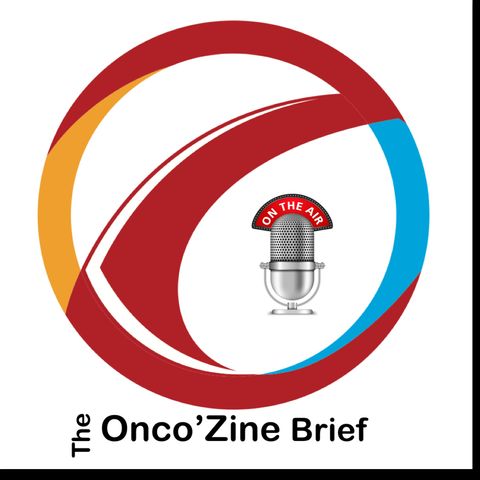Developing a New Standard of Care: Cancer Treatment with Photoimmunotherapy

Download and listen anywhere
Download your favorite episodes and enjoy them, wherever you are! Sign up or log in now to access offline listening.
Developing a New Standard of Care: Cancer Treatment with Photoimmunotherapy
This is an automatically generated transcript. Please note that complete accuracy is not guaranteed.
Description
In a new episode of The Onco'Zine Brief, Peter Hofland talks with David M. Cognetti, MD, a Professor and Chair in the Department Head and Neck Surgery at Thomas Jefferson...
show moreHofland and Cognetti talk about head and neck cancer and a novel treatment approach called Photoimmunotherapy.
Head and Neck Cancer
According to the American Cancer Society, Head and neck cancer accounts for about 4% of all cancers in the United States. In the United States in 2023, an estimated 67,000 people will be diagnosed with head and neck cancer and about 15,000 patients are expected to die of the disease.
Today, many cancers of the head and neck can be cured, especially if they are found early. And while eliminating the cancer is the primary goal of treatment, preserving the function of the nearby nerves, organs, and tissues is also very important.
Beyond Current Treatment
Photoimmunotherapy is a recently developed hybrid cancer therapy to treat diseases by linking specific antibodies with photosensitizers to form photoimmunoconjugates.
But let’s go back to the beginning.
Surgery, radiation, and chemotherapy have dominated the treatment of oncologic. These therapies aim to eradicate cancer cells but, unfortunately, do that at the expense of normal, or healthy cells/ In turn, this can lead to severe and sometimes lethal side-effects.
Overall, the success of surgery, radiation and chemotherapy is measured by what we call a ‘therapeutic index.’
This ‘therapeutic index’ compares the potential benefits of treatment to the potential risks associated with treatment.
Unfortunately, the unintended, off-target side effects of these therapies can have profound effects on the health-related quality of life of patients.
For example, both radiation and chemotherapy sometimes preferentially kill lymphocytes much earlier than cancer cells because of the increased radiation sensitivity and high proliferation rate of lymphocytes, potentially leading to dose-limiting toxicity for some chemotherapy regimens.
To find a solution, researchers have developed new therapeutic strategies. And while these therapies have created an exciting new direction for the treatment of cancer therapy, there remain limitation to these novel approaches.
Now, in theory, the perfect cancer therapy would both directly destroy cancer cells to minimize residual cancer cells as well as activate the local host immune response to wipe out remaining cancer cells.
And while such a therapy would be highly selective for cancer cells but have minimal or no off-target effects in the tumor microenvironment.
Photoimmunotherapy
And that’s where photoimmunotherapy comes in. Photoimmunotherapy, designed to selectively destroy target cells.
The therapy that induces direct cancer killing via immunogenic cell death, thus activating the anti-cancer immune system locally in the tumor microenvironment.
The specificity of this approach comes from the antibody that is designed to target an expressed antigen on the tumor surface and is conjugated to the photo-activating chemical.
The safety of Photoimmunotherapy is based on the fact that the antibody–photo-absorber conjugate predominantly binds to specifically targeted cancer cells and that it is only activated in areas exposed to Near-infrared light at a specific activating wavelength.
By choosing tumor-specific antigens, this therapy specifically destroys cancer cells while not or only minimally harming any adjacent normal or healthy cells, particularly tumor-infiltrating immune T cells or blood vessels. Furthermore, the photo-activating chemical is a water-soluble photo-absorbing dye without cytotoxic properties of its own.
Clinical studies have shown that this combination can enhance the immune response, and, as a result, have a good effect on the treatment of residual tumor and metastatic cancer.
The first human study of a Photoimmunotherapy was with ASP-1929 – which is being developed by Rakuten Medical to treat inoperable head and neck cancer.
ASP-1929 is a conjugate of cetuximab, an anti-EGFR antibody plus the photo-absorber called IR700.
About The Onco'Zine Brief
The Onco'Zine Brief is distributed in the United States via PRX (Public Radio Exchange). In the United Kingdom and Europe, the program is distributed via UK Health Radio (UKHR). And the program can be downloaded via most podcasts and streaming media services, including iTunes, Spotify, TuneIn, and iHeart Radio.
For more information about The Onco'Zine Brief or how to sponsor or support this public radio broadcast and podcast, visit to download our Media Kit, visit our Patreon page, or contact the sales team.
To sign up for The Onco'Zine Newsletter (open for residents of the United States only), text the word CANCER to 66866.
The Onco’Zine Brief is made possible, in part, by Java Original Coffee and Roastmasterz by Java Original Coffee.
.
Clinical trials
ASP-1929 Photoimmunotherapy (PIT) Study in Recurrent Head/Neck Cancer for Patients Who Have Failed at Least Two Lines of Therapy - NCT03769506
ASP-1929 Photoimmunotherapy Combined With Pembrolizumab in Patients With Recurrent Head and Neck Cancer, With or Without Metastases - NCT05265013
ASP-1929 Photoimmunotherapy (PIT) Study in in Patients With Recurrent Head/Neck Cancer - NCT05182866
An Open-label Study Using ASP-1929 Photoimmunotherapy in Combination With Anti-PD1 Therapy in EGFR Expressing Advanced Solid Tumors - NCT04305795
Reference
[1] Kobayashi H, Furusawa A, Rosenberg A, Choyke PL. Near-infrared photoimmunotherapy of cancer: a new approach that kills cancer cells and enhances anti-cancer host immunity. Int Immunol. 2021 Jan 1;33(1):7-15. doi: 10.1093/intimm/dxaa037. PMID: 32496557; PMCID: PMC7771006.
[2] Kobayashi H, Griffiths GL, Choyke PL. Near-Infrared Photoimmunotherapy: Photoactivatable Antibody-Drug Conjugates (ADCs). Bioconjug Chem. 2020 Jan 15;31(1):28-36. doi: 10.1021/acs.bioconjchem.9b00546. Epub 2019 Sep 13. PMID: 31479610; PMCID: PMC7414968.
Feature Image Courtesy: © 2020 U.S. Department of Health and Human Services, National Institutes of Health, National Cancer Institute. Used with permission.
=====
Information
| Author | Peter Hofland |
| Organization | Peter Hofland |
| Website | - |
| Tags |
Copyright 2024 - Spreaker Inc. an iHeartMedia Company
